Purpose
The purpose of this activity is to support students in anticipating the result of repeating (iterating) a unit rate.
Achievement Objectives
NA4-4: Apply simple linear proportions, including ordering fractions.
Required Resource Materials
- Calculators
Activity
- Share this problem with your students:
Imagine you go on a cycle trail. The land is flat, so you cycle at the same speed of 1 kilometre every 5 minutes. How long will it take you to ride 10 kilometres? You might present this problem in relation to a nearby cycle trail.
Let students attempt the problem individually or in pairs. Ask them to record how they worked out the answer. If necessary, model an appropriate means of expression (e.g. a written expression).
- Gather the class, and provide time for students to share their ideas. This might include students using ‘build up’ strategies like double counting, meaning students verbally count “five, ten, fifteen, …” whilst also counting (tracking) the number of kilometres on their fingers.
- Use students’ working as a basis for creating useful representations, such as:
A double number line that allows the students to see the relative size of the two measures.

- A rate table that organises the measures and numbers and makes it easier for students to see patterns.
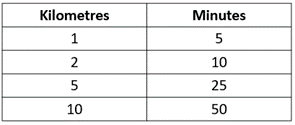
- Pose further problems that use the same context of a cycle trail but vary both the speed and the target time or distance. In all problems allow the possibility of build-up strategies, but make multiplicative thinking increasingly attractive. Let students have access to pencils, paper, and calculators, as required.
Provide opportunities for students to work, and share their thinking, in a variety of groupings that encourage independent, paired, and guided success, scaffolding, and extension. Consider introducing relevant te reo Māori kupu, such as pāpātanga (rate), manomita (kilometre), and meneti (minute).
Good problems and representations are:- You cycle at the same speed of 1 kilometre every 3 minutes. How much time will it take you to ride 10 kilometres?

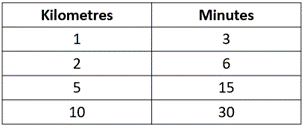
- You cycle at the same speed of 1 kilometre every 4 minutes. How much time will it take you to ride 15 kilometres?
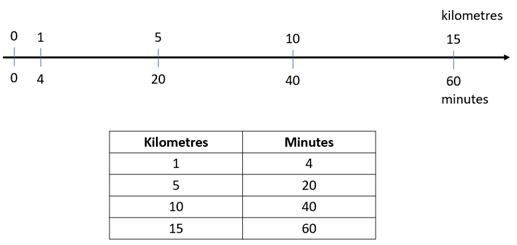
- Change the target number from time to distance.
You cycle at the same speed of 1 kilometre every 5 minutes. How many kilometres will you ride in 40 minutes?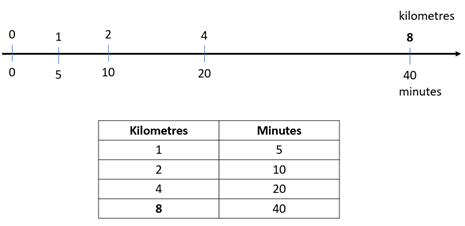
- You cycle at the same speed of 1 kilometre every 4 minutes. How many kilometres will you ride in 60 minutes?
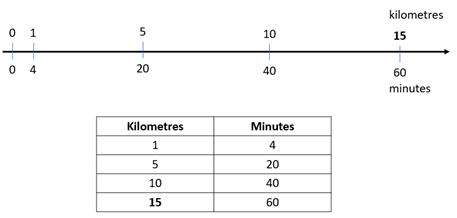
- Set both time and distance as targets.
You cycle at the same speed of 1 kilometre every 3 minutes.
How many kilometres will you ride in 45 minutes?
How many minutes will it take you to ride 20 kilometres?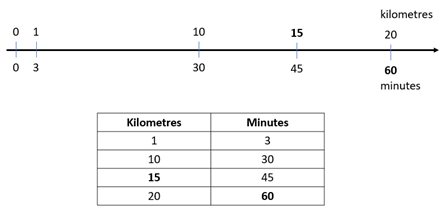
- You cycle at the same speed of 1 kilometre every 3 minutes. How much time will it take you to ride 10 kilometres?
Next steps
- Maintain the focus on applying unit rates but make the numbers less attractive for build-up additive or skip counting strategies. For example:
Your car travels at the same speed of 75 kilometres per hour.
How many kilometres will you travel in 4 hours?
How many hours will it take you to travel 450 kilometres?
Encourage students to use paper-based and mental strategies but allow use of calculators. Once the burden of calculation is lifted students are likely to use more efficient calculations, such as: 4 x 75 = 300 kilometres and 450 ÷ 75 = 6 hours.
- Use other contexts for applying unit rates so that students generalise the characteristics of those contexts. Use measurements for other attributes such as capacity and weight.
Example might be:- The barber does 4 haircuts every hour. How many haircuts does she do in 8 hours?
- Every carton of eggs weighs 600 grams. How many grams do 7 packets weigh?
- Mere puts 1 cup of concentrate with every 6 cups of water. If she uses 42 cups of water, how many cups of concentrate does she need?
- A tap fills the bath by 5 litres every minute. How long does it take to put 100 litres into the bath?
Add to plan
Level Four